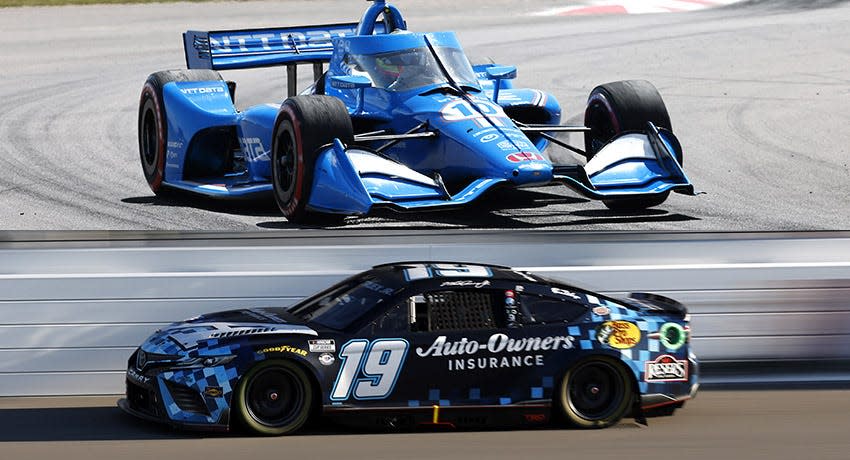Is IndyCar the same as NASCAR? And other auto racing FAQs

IndyCar and NASCAR are two popular auto racing series based in the United States.
The 2023 IndyCar schedule includes 17 races, starting on the streets of St. Petersburg, Fla., in March, and finishing at WeatherTech Raceway Laguna Seca on Sept. 10. Races are run on downtown streets, road courses and oval speedways.
The 2023 NASCAR Cup schedule is 36 races starting with its biggest event, the Daytona 500, in February, and finishing at Phoenix on Nov. 5. Most races are run on ovals, but six are road or street courses (Austin, Sonoma, Chicago, Indianapolis, Watkins Glen, Charlotte). One race, at Bristol, Tenn., is run on a dirt oval track.
Open-wheel series: Here are the key differences between F1 and IndyCar
Is IndyCar faster than NASCAR?
An IndyCar machine produces 550-700 horsepower, with a top speed over 240 mph on the straightaways at Indianapolis Motor Speedway. Scott Dixon's pole qualifying speed for the 2022 Indy 500 was 234.036 mph over 4 laps on the 2.5-mile oval.
NASCAR Cup cars produce 650-770 hp (450 with restrictor plates at Daytona, Talladega). Alex Bowman's 2023 Daytona 500 pole speed was 181.686 mph. Cup cars can top 200 mph.
Does NASCAR own IndyCar?
IndyCar and the Indianapolis Motor Speedway are owned by Roger Penske via Penske Entertainment Corp., a subsidiary of Penske Corporation.
The National Association for Stock Car Auto Racing, LLC (NASCAR) was founded by Bill France in 1948. His son, Jim France, has been CEO since 2018. Penske owns cars that compete in NASCAR.
Do IndyCar drivers also drive NASCAR?
Conor Daly is an IndyCar regular who competed in the 2023 Daytona 500. Several drivers have completed the "Double," competing in the Indianapolis 500 and NASCAR's 600-mile race in Charlotte, N.C., on the same day (most recently Kurt Busch in 2014). NASCAR's Kyle Larson has plans to do so in 2024.
NASCAR/IndyCar doubleheader 2023
In 2022, both series competed on the same track on the same weekend for the first time, the Indianapolis Motor Speedway road course. The series are scheduled to do so again in 2023 (Aug. 12-13).
IndyCar vs. NASCAR car size
IndyCar dimensions: 1,590-1,630 pounds, depending on track (lightest on speedways); about 40 inches tall; about 76 inches wide; tires are 15 inches in diameter. IndyCar machines use E85 fuel (85% ethanol) and a tank holds 18.5 gallons.
NASCAR Cup dimensions: 3,200 pounds; about 53 inches tall; about 18-inch wheels; E15 fuel (15% ethanol), and a tank holds 18 gallons.
IndyCar vs. NASCAR driver salaries
IndyStar reported in 2021 that 2009 Indianapolis 500 champion Scott Dixon had a salary in the $3.5 million-$4.5 million range, the highest in the series at the time. A more common pay structure among the series' drivers is that they must bring millions of dollars of sponsorship to their team, and they get a cut of it, and they could get performance bonuses.
Kyle Busch has the reported highest annual salary in NASCAR at $16.9 million. A handful of other drivers top $10 million. A more common range is $1 million-$4 million.
IndyCar vs. NASCAR popularity
NBC Sports, IndyCar's flagship network, reported that races averaged 1.3 million viewers in 2022, with the Indianapolis 500 drawing 4.8 million.
NASCAR Cup races are carried on Fox (first half of the season) and NBC networks (back half of the season). The season-opening Daytona 500 drew 8.2 million viewers. Many Cup races draw between 3 million-4 million viewers.
IndyCar vs. NASCAR costs
IndyCar programs can run up to $10 million per car. The series has two engine manufacturers (Honda and Chevrolet) and one chassis maker (Dallara).
NASCAR Cup programs are $15.6 million per car or more. Toyota, Chevrolet and Ford provide NASCAR engines, and Technique makes chassis.
This article originally appeared on Indianapolis Star: IndyCar vs. NASCAR differences: Which car is faster, bigger
